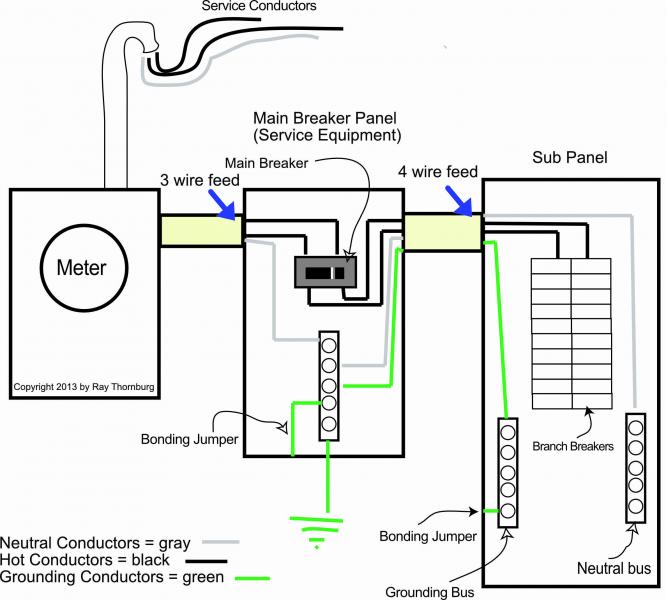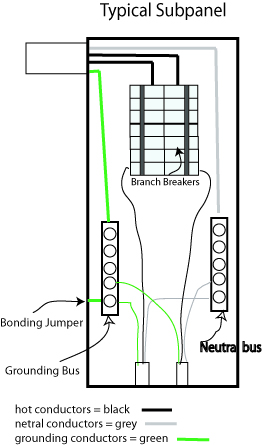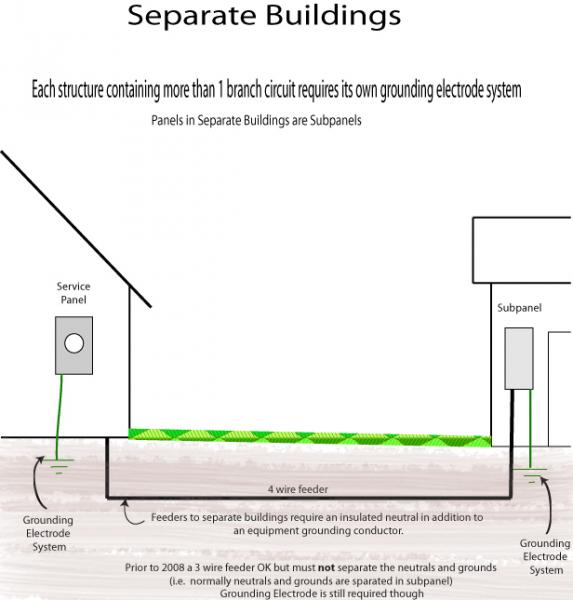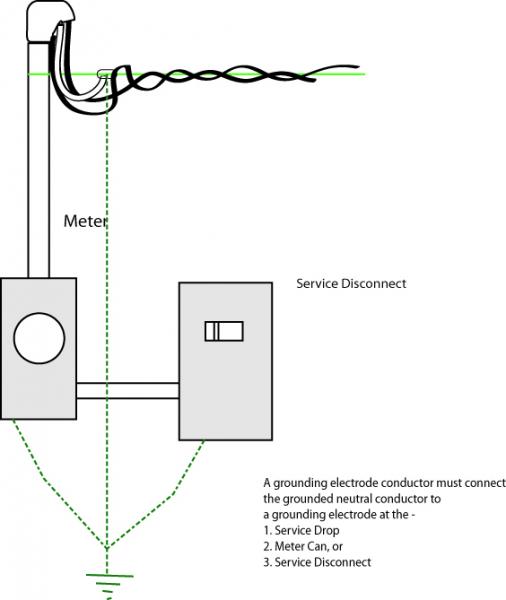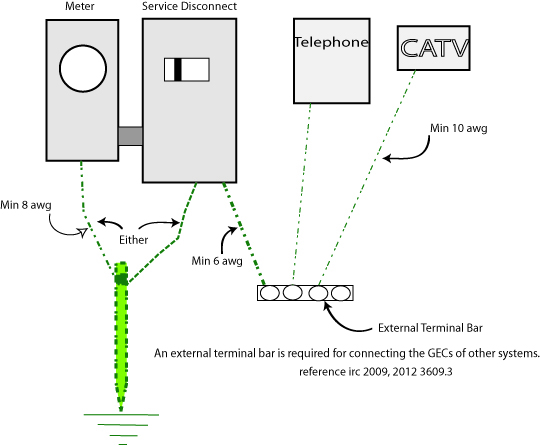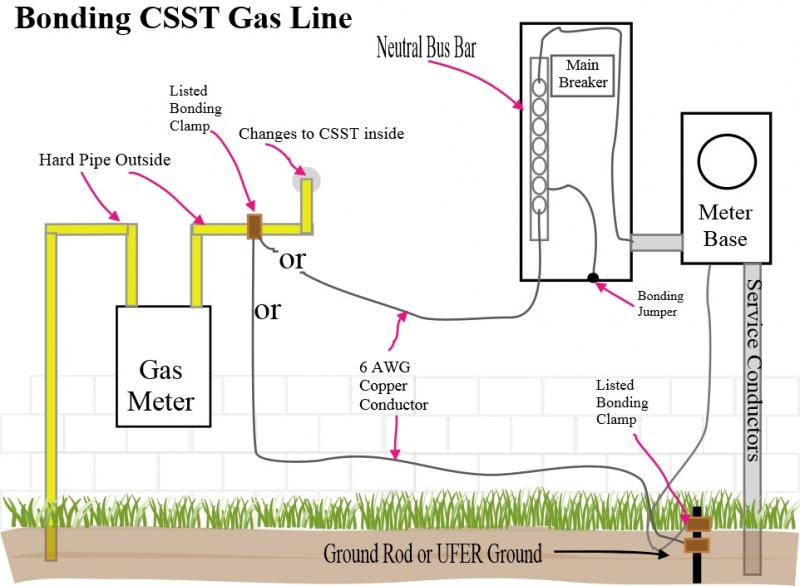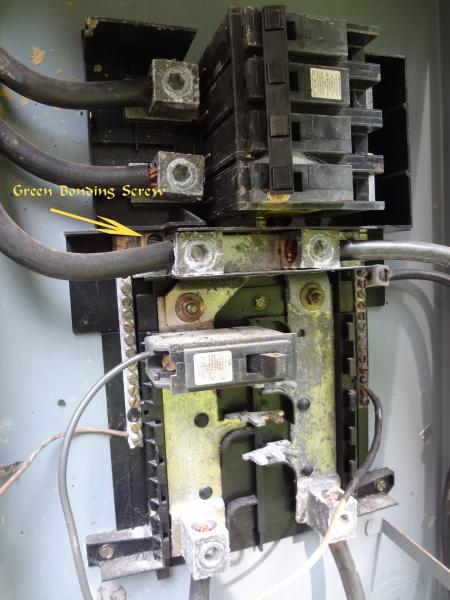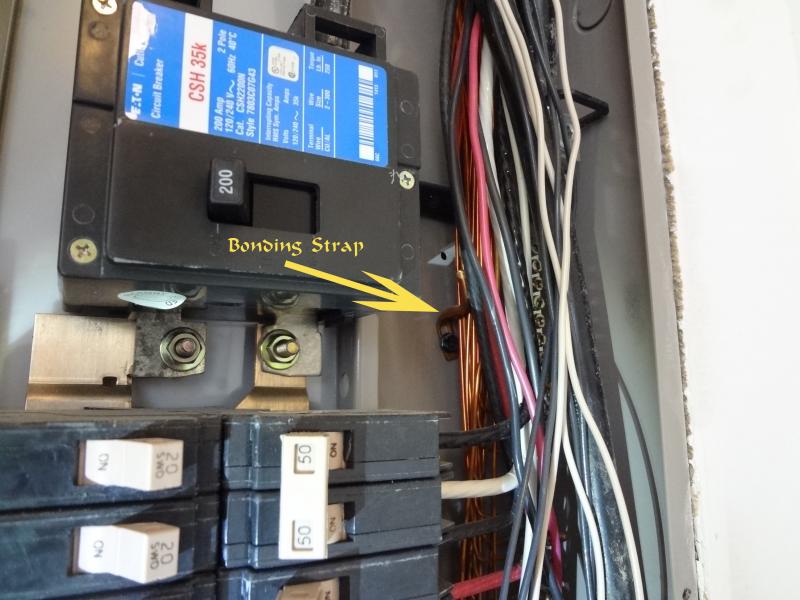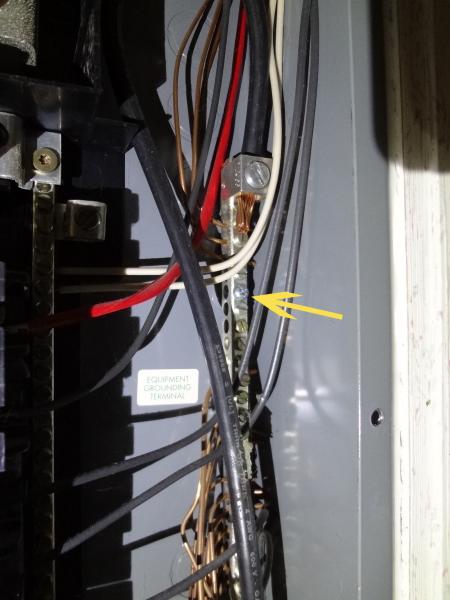- Home - Blue Palmetto Home Inspection of Summerville and Charleston
- Learn About Us and This Charleston Home Inspector
- What's Inspected
- Charleston Lowcountry Inspection Areas (geographic)
- Testimonials
- >>>Blogs (educational)
- Sample Reports & Documents
- Why Get a Home Inspection Report
- Charleston's Top Ten Reasons
- Home Inspector Photo Galleries
- Pricing
- Scheduling and Customer Information
- Home Inspection Authorization Contract
- General Scope of Work (electronic)
- Home Inspection Customer Satisfaction Survey
- Privacy Policy
- Full site
- The Roof Framers Field Manual
What is the difference between grounding and bonding?
Submitted by Ray Thornburg on Sat, 06/09/2012 - 09:28
What is the difference between grounding and bonding?
 Non-technical version
Non-technical version
To understand why this is important we must acknowledge some basic facts. First as we move around in the world electric charges are everywhere (think static electricity). Metal objects have a tendency to accumulate a charge. If the charges between metal objects are different then an arc or spark could develop. This is called potential difference. If there is no potential difference then there is no current flow and thusly no danger of spark. (Imagine a water pipe where the pressure is the same between two points in the piping system then no water can flow.) This is what bonding is all about. Bonding is just another way to say “to connect metal parts of a system so that there is no potential difference between them.” This is usually accomplished with a conductor (piece of wire) connected to both parts and shall be provided where necessary.
Bonding is important because if a charge develops in any system then you could get a shock or even worse an explosion under certain circumstances. For instances flammable vapors or a incorrectly wired receptacle. Now if a charge develops in a system it has to have somewhere to go. (think about the shock you get from static electricity). This is where grounding comes in.
Now that we have everything bonded to equalize potential difference it is time to ground the parts that are bonded. The earth has an infinite ability to absorb electrons; so bonded parts are directed to a ground rod at the service entrance. This is called the grounding electrode (GE) which is usually a rod driven into the ground about eight feet. There are also other ways to do this. A GE is driven into the ground where the electric service (think electric meter) enters the home. The electric service and other systems which are bonded should be connected to the GE. So you see here that bonding without grounding is useless. Bonded parts have to be eventually grounded. Think for a moment that if bonded parts were not grounded and were to receive a charge then if a person were to touch that part then the current will flow through the person trying to find its way back to its source (the transformer). The earth by itself is not an effective fault current path because it has too much resistance so a ground rod which is not connected back to the service would do no good. Also I wanted to mention that the ground rod is at the service where the gounding and neutral conductors are joined. Adding other ground rods for the heck of it (like at a lamp post for instance) will not protect against shock and might make it more likely for equipment to be damaged due to it introducing another path for stray voltage to enter the system.
Grounding is the act of connecting bonded parts to a grounding electrode.
There are a lot of rules about which systems need to be bonded and grounded and the methods by which to accomplish all of this. Below is a picture (courtesy of internachi) which show how this works.
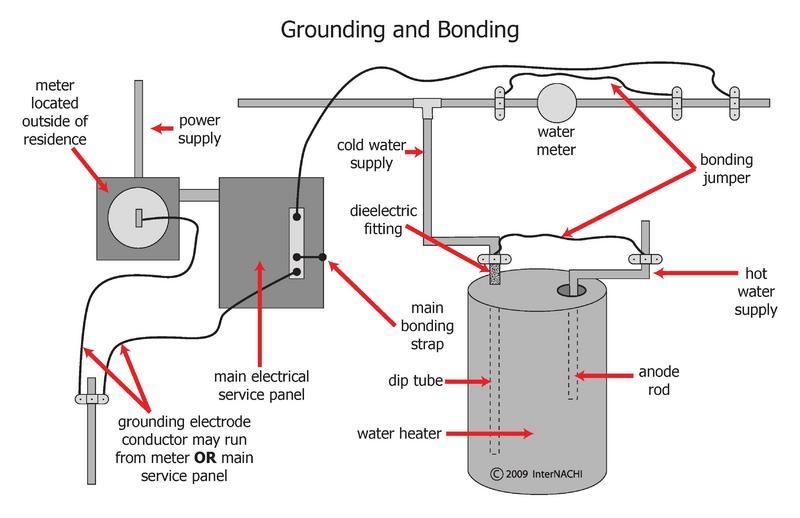
Bear in mind that it is the grounding conductor (the bare metal or green wire that is connected to the ground terminal of a receptacle for instance) that is bonded (connected) to metal parts along the way back to the service where it is grounded that helps protect a person from electric shock. It acts as a secondary return path for current to travel in the event of a fault.
To the left is a diagram courtesy of me. It shows how to properly ground and bond the main panel. Notice that the neutrals and grounds can be mixed ( connected to the same bus bar) in the main panel but not in the subpanel. This keeps the current traveling where we want it to. Any other way could be unsafe. Notice also the bonding jumpers. All panels must have the grounding bus bonded to the enclosure. In the service equipment neutrals must be bonded as well. Click image to enlarge.
At the Main Service Disconnect- Where the neutral is insulated from the enclosure, install a main bonding jumper or screw with a green finish.
All Panels- Grounding Terminal Bus (not neutral) - Where insulated from the enclosure, install a main bonding jumper or screw with a green finish.
For more information about Panels, Subpanels and Local Disconnects click the link and it'll take you to my new sister website I'm working on.
reference 250.8, 250.28, 230.75
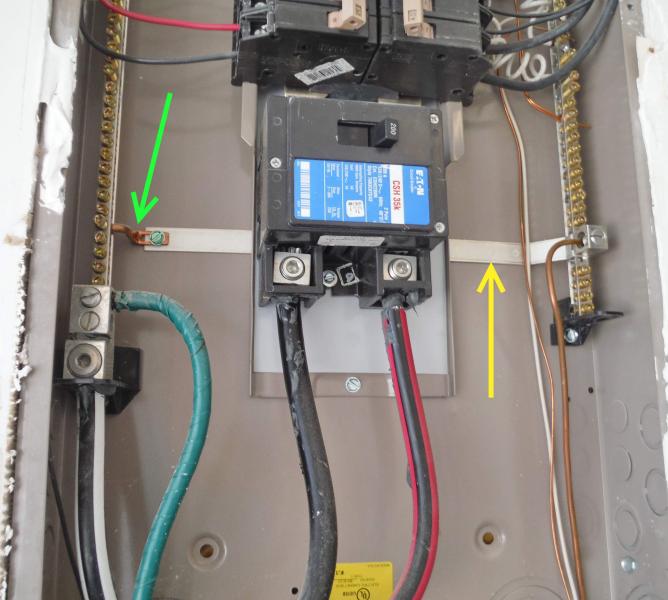 Proper Bonding- At left shows a main service panel disconnect fed with a three conductor service cable (two hot and a neutral). In this case the grounding terminal is bonded to the neutral terminal using the bonding screw (green arrow) provided by the manufacturer. The yellow arrow shows the bonding bar used to accomplish this. So in the main panel only (like this one) the grounding and neutral conductors can be on the same bus terminal if desired. If the panel is fed by a three wire feeder has a separate grounding bar (no neutrals on it) then it must be bonded to the neutral bar with a bonding jumper.
Proper Bonding- At left shows a main service panel disconnect fed with a three conductor service cable (two hot and a neutral). In this case the grounding terminal is bonded to the neutral terminal using the bonding screw (green arrow) provided by the manufacturer. The yellow arrow shows the bonding bar used to accomplish this. So in the main panel only (like this one) the grounding and neutral conductors can be on the same bus terminal if desired. If the panel is fed by a three wire feeder has a separate grounding bar (no neutrals on it) then it must be bonded to the neutral bar with a bonding jumper.
At left shows how the branch circuit conductors are separated in the subpanel. The legend is for illustrative purposes. In real life hot conductors are generally (but not always) black or red, neutral is white or grey and grounding conductors are green or bare. The thing to remember is this - Only the service is fed with a three wire feeder. Any panel after the service panel (where the main breaker is) must be fed by a four wire feeder. After the service the neutral and grounding conductors cannot be re-bonded together. This has been the rule since 1913.
In the past there were exceptions for detached structures (see drawing below about that).
Pictured is a bonding screw on a metal mobile home frame. Notice the two conductors. One goes to the telephone ground one goes to the grounding terminal in the electrical distribution panel box. Click Image to enlarge.
At left is the cable tv system and the bonding conductor clearly visible.
Pictured at left is a ground rod stuck up out of the ground. These should be driven flush. Probably erosion of soil caused this. Also pictured are the grounding clamps.
Ufer type ground rod pictured with grounding cable. A ufer type ground is one which is encased in concrete footing which is exposed on the bottom to the earth.
At left is an antenna bonded to the metal frame of a mobile home. The frame is bonded to grounding conductor at the service panel. Because the connector is screwed to the metal frame (bonded) a separate bonding conductor is not needed.
At left you can see a proper bonding clamp to the gas meter to the csst gas line (not visible).The manufacturers require this bond, typically a minimum #6 AWG, and it is connected to the regular steel piping after the meter and before it enters the structure, the other end of the bonding conductor goes to the service where the grounding electrode is connected or to one of the grounding electrodes as all of the grounding electrodes are required to be bonded together.
At left shows that a grounding electrode system is needed at both buildings if there is more than one branch circuit. Click image to enlarge.
At left shows the grounding electrode conductor requirements per nec 250.24. Click image to enlarge.
Picture shows how intersystem bonding is accomplished. reference irc 3609.3
Picture shows bonding procedure for when CSST gas line piping is used. This has always been required by the manufacturer and by codes since at least 2009 no matter which type of CSST is used. Reference IRC 2012 G2411.1.1. Use not less than a # 6 AWG copper or equivalent bonding jumper. The bonding shall connect to the metal piping between the point of delivery and the first downstream CSST fitting.
Sometimes its not immediately apparent how the enclosure is bonded. Picture shows a main panel feeding a subpanel. Shown are two neutral terminals separated by a plastic insulator. The green screw (on both sides) is how this one is bonded. Occasionally we find one of the green screws is absent or the bonding strap is not connected to the grounding terminal which is a deficiency. Remember that all panels must have the grounding bus bonded to the enclosure. In the service equipment (like this one) neutrals must be bonded as well. If this was a subpanel the neutrals and grounds would be separated but the grounding terminal would be bonded to the enclosure.
The manufacturer provided this listed bonding strap to bond the grounding terminal (to the enclosure) in this main panel. It should have been used. Sometimes the grounding terminal is only bonded to the enclosure by its mounting screws.
Here is an example of an equipment grounding terminal bonded to the enclosure by its mounting screws. Remember that all panels must have the grounding bus bonded to the enclosure. In a subpanel like this one the neutrals are separate from the grounding conductors and are not bonded to the enclosure or to each other.
A non contact voltage detector will light up when it comes near a switch which is ungrounded if the switch is in the on position. Appliances with metal enclosures can be tested the same way. If the detector lights up when the appliance is off then there may be a dangerous ground fault condition.
At left is the switch with the wall plate removed showing the green grounding screw without the grounding conductor connected. Proof that the detector did not lie to us. Snap switches like this have required grounding since 1993 but in 1999 the language was expanded to include all snap and dimmer switches with or without a metal faceplate as long as a grounding means exists in the box.
In 1962 the NEC began requiring grounding general use receptacles (three prong outlets). Before that most outlets were of the two prong type without a grounding conductor.
Between 1962 and 1968 it was allowed that a NM cable could have a smaller EGC (equipment grounding conductor) than the circuit was rated for. For example a 20 amp circuit could have a 16 AWG conductor for the EGC. Since then all the conductors must be the same size including the EGC.
Often in older homes outlets are often replaced without much thought. If an older home for instance has a three prong outlet it must have a properly connected grounding conductor or be GFI protected for safety. It must also have a label on it which says "no equipment ground".The other option would be to replace it with a two prong receptacle.
The metal parts of light fixtures have been required to have grounding since the adaption of the 1975 NEC. Adaption of any codes locally often lag a few years behind its introduction in the code book. Also local enforcement of the rules are often sporadic and not consistent. So it would be next to impossible for an inspector to tell exactly when a rule was required but this gives you a general idea.

